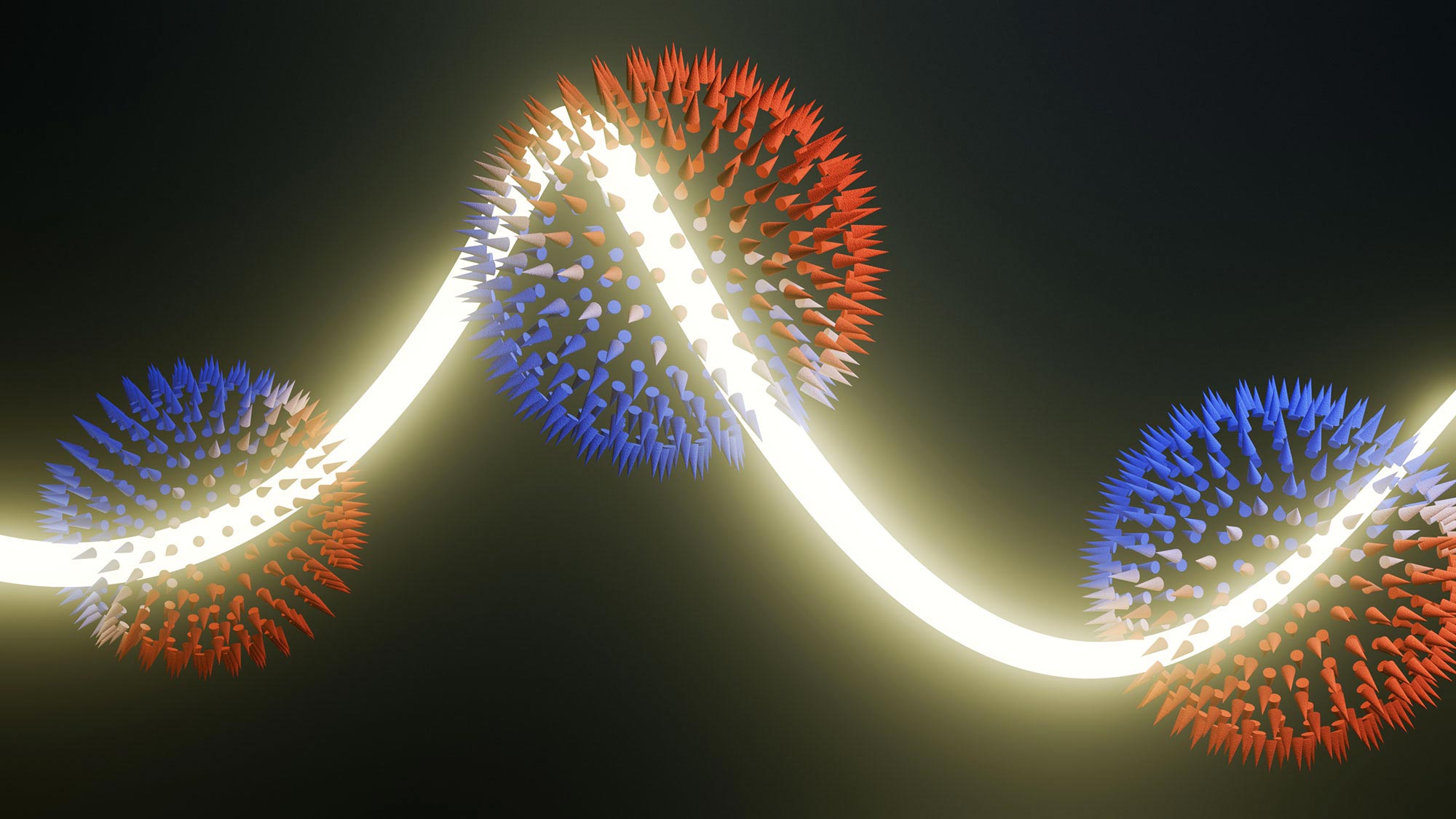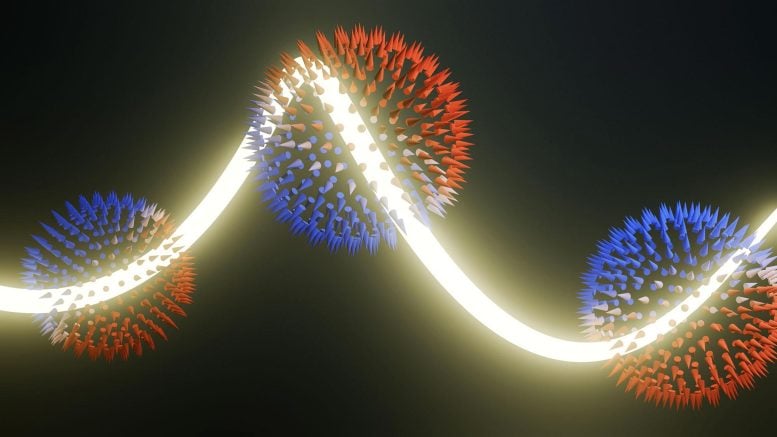

New research has identified orbital angular momentum monopoles in chiral materials, offering a leap forward in developing energy-efficient electronic devices. This could lead to significant advances in orbitronics, a new kind of electronics based on electron orbits rather than spins.
Scientists at the Max Planck Institute of Microstructure Physics, along with international collaborators, have observed orbital angular momentum (OAM) monopoles in chiral materials for the first time. This discovery, published in Nature Physics, could be a significant breakthrough for next-generation electronic devices, especially in the emerging field of chiral electronics.
Revolutionizing Information Transfer: The Rise of Orbitronics
In traditional electronics, information is transmitted using the charge of electrons. However, future technologies may shift to using another property of electrons: their intrinsic angular momentum. Historically, much of the focus has been on electron spin, which produces a magnetic moment and has been seen as the leading contender for next-generation devices. Now, researchers are turning their attention to orbitronics—a field that uses the angular momentum created by electrons as they orbit the nucleus. Orbitronics holds great potential for energy-efficient memory devices, as it can produce strong magnetizations with minimal charge currents.
A critical challenge in orbitronics has been identifying the right materials to generate large orbital polarizations. Recent advances have made progress using conventional materials like titanium. However, chiral materials, which often have a unique helical atomic structure similar to the DNA double helix, offer an exciting alternative. These materials naturally possess OAM textures as an intrinsic property, making them particularly attractive for orbitronics.
Dr. Niels Schröter, an independent group leader at the Max Planck Institute of Microstructure Physics and lead author of the study, explains that “chiral materials are anticipated to be significant and controllable sources of orbitally polarized electrons, which could contribute to the development of more energy-efficient memory and computing devices.”
Discovery of OAM Monopoles: Breaking the Symmetry
Another unusual and advantageous feature of such materials is their potential to host monopoles of OAMs within their electronic band structures. In this scenario, OAM behaves in ways that defy the rules of symmetry seen in conventional systems. For example, in magnets, we expect a north and south pole, rather than an isolated monopole.
At these monopoles, OAM radiates outwards like the spikes of a scared hedgehog curled into a ball. And this is what makes these materials so attractive: OAM is uniform in all directions – i.e. it is isotropic.
“This makes these materials special, as the direction along which the orbital angular momentum is polarized only depends on the direction of the injected charge current, and not the orientation of the crystal” says Dr. Jonas Krieger, formerly a Postdoc at the Max Planck Institute of Microstructure Physics, who led the experimental team that made the discovery. Dr. Krieger is now a tenure-track scientist at the Paul Scherrer Institute in Switzerland where he still closely collaborates with his colleagues from Germany.
Overcoming Experimental Challenges
OAM monopoles in chiral crystals have long been an exciting prospect for orbitronics, but until now, they had only existed in theory. Observing them experimentally has been a significant challenge. The key to unlocking this mystery lay in a technique called Circular Dichroism in Angle-Resolved Photoemission Spectroscopy, or CD-ARPES, which uses X-rays from a synchrotron light source. Despite its potential, previous attempts to detect OAM monopoles with this method had been unsuccessful.
“There was a disconnect between theory and experiment. Researchers may have collected the right data, but the evidence for OAM monopoles was hidden within it,” explains Dr. Michael Schüler from the Paul Scherrer Institute, who supervised the development of theoretical models that were used to interpret the data.
The difficulty stemmed from interpreting the complex data generated by CD-ARPES. In this technique, light is shone onto a material, ejecting electrons. The angles and energies of these ejected electrons provide insights into the material’s electronic structure. When circularly polarized light is used, it was initially assumed that the measurements would directly reflect the OAMs.
“That assumption turned out to be too simplistic. Our study revealed that the reality is much more complicated,” says Dr. Schüler.
Empirical Insights and Theoretical Advances
Determined to untangle the complex web of CD-ARPES data to reveal the existence of OAM monopoles, Schröter, Krieger, Schüler, and colleagues examined two types of chiral crystals: those made of palladium and gallium or platinum and gallium, which were synthesized at the Max Planck Institute for Chemical Physics in Dresden in the Group of Prof. Claudia Felser.
The team approached the puzzle with an open mind to challenge every assumption. They then made an unusual extra step of performing the experiments at various photon energies. “At first, the data didn’t make sense. The signal seemed to be changing all over the place,” says Schüler.
By carefully comparing the experimental data to theoretical models, the scientists unpicked how different contributions complicated calculations of OAM from CD-ARPES data. In this way, they demonstrated how the CD-ARPES signal was not directly proportional to the OAMs, as previously believed, but rotated around the monopoles as the photon energy was changed. The theoretical model that they finally built fitted the CD-ARPES data regardless of the crystal orientation or photon energy tested.
In this way, they proved the presence of OAM monopoles. “The smoking gun was robustness,” explains Schröter. “Certain features persisted no matter which conditions we used. The only way to have this is with OAM monopoles, where the OAM is isotropic.”
Armed with the ability to accurately visualise OAM monopoles, Schröter and colleagues went on to show that the polarity of the monopole – whether the spikes of OAMs point inwards or outwards – could be reversed by using a crystal with a mirror image chirality. “We have therefore discovered a structure-property relationship that allows us to control the orbital response via the structural chirality of the crystal”, says Schröter.
Implications and Future Prospects in Chiral Electronics
This discovery not only marks a significant milestone in orbitronics but also aligns with the goals of the newly proposed Center for Chiral Electronics, a joint initiative between the Max Planck Institute of Microstructure Physics and the universities in Halle, Berlin, and Regensburg. The Center aims to address the growing need for more efficient data storage and processing technologies. By exploring the unique properties of chirality in electronic applications, the Center will develop new devices with advanced functionalities.
For more on this research, see Orbitronics Emerges As Energy-Efficient Tech of Tomorrow.
Reference: “Controllable orbital angular momentum monopoles in chiral topological semimetals” by Yun Yen, Jonas A. Krieger, Mengyu Yao, Iñigo Robredo, Kaustuv Manna, Qun Yang, Emily C. McFarlane, Chandra Shekhar, Horst Borrmann, Samuel Stolz, Roland Widmer, Oliver Gröning, Vladimir N. Strocov, Stuart S. P. Parkin, Claudia Felser, Maia G. Vergniory, Michael Schüler and Niels B. M. Schröter, 30 September 2024, Nature Physics.
DOI: 10.1038/s41567-024-02655-1